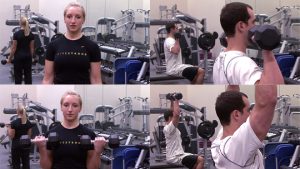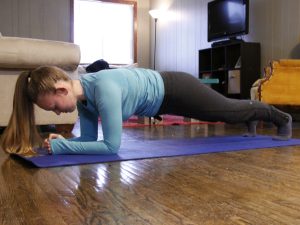11.2 Muscular Strength and Endurance Defined
Muscular strength and endurance is another component of fitness associated with health benefits. Both muscular strength and muscular endurance are enhanced through resistance training—also known as strength training—activities. Muscular strength refers to the amount of force that a muscle can produce with a single maximum effort. Muscular endurance refers to the ability to hold a given level of muscle tension for a period of time or repeat such a muscle contraction multiple times before reaching fatigue (Swain et al., 2014).
Types of Muscular Strength and Endurance Exercises
Dynamic Resistance Exercise Defined
Dynamic resistance exercises, also known as isotonic exercises, are those resulting in a change in the length of the muscle; a biceps curl is a good example. The concentric contraction is the shortening of the muscle—lifting the weight—and the eccentric contraction is the lengthening of the muscle—lowering the weight. Completing both phases is considered one repetition, and multiple repetitions make up a set.
Dynamic exercises are a popular form of strengthening exercises; they work through a muscle’s full range of motion and can be performed with free weights, weight machines, resistance bands, or a person’s own body weight. Another type of dynamic exercise is called plyometrics. Plyometric exercises help develop explosive strength useful in sports and typically involve jumping and quick changes in direction. They help enhance not only muscular strength and endurance, but also cardiorespiratory endurance.

Static Resistance Exercises
Static resistance exercises, also known as isometric exercises, involve muscle contraction without a resulting change in muscle length or joint angle. They make use of an immovable object like a wall to provide resistance or involve tightening a muscle while holding still. A good example is holding a plank position or performing a wall-sit. The downside compared to dynamic exercises is that strength isn’t developed throughout the muscle’s full range of motion. However, static exercises can be useful in overcoming weak points in a particular muscle’s range of motion or for maintaining or building strength following an injury when range of motion is limited.

Learning Activity: Defining Terms Related to Muscular Strength and Endurance
Practice your comprehension of muscular strength and endurance vocabulary in this drag and drop activity.
Self-Assess Your Understanding
- Define muscular strength.
- Define muscular endurance.
- Distinguish between dynamic resistance exercises and static resistance exercises.
refers to the amount of force that a muscle can produce with a single maximum effort
refers to the ability to hold a given level of muscle tension for a period of time or repeat such a muscle contraction multiple times before reaching fatigue
also known as isotonic exercises--are those resulting in a change in the length of the muscle; a biceps curl is a good example
the shortening of the muscle—lifting the weight
the lengthening of the muscle—lowering the weight
a series of multiple repetitions of a strength exercise
a type of dynamic exercise designed to help develop explosive strength useful in sports; typically involve jumping and quick changes in direction.
also known as isometric exercises, involve muscle contraction without a resulting change in muscle length or joint angle; make use of an immovable object like a wall to provide resistance or involve tightening a muscle while holding still (examples: holding a plank position or performing a wall-sit)

